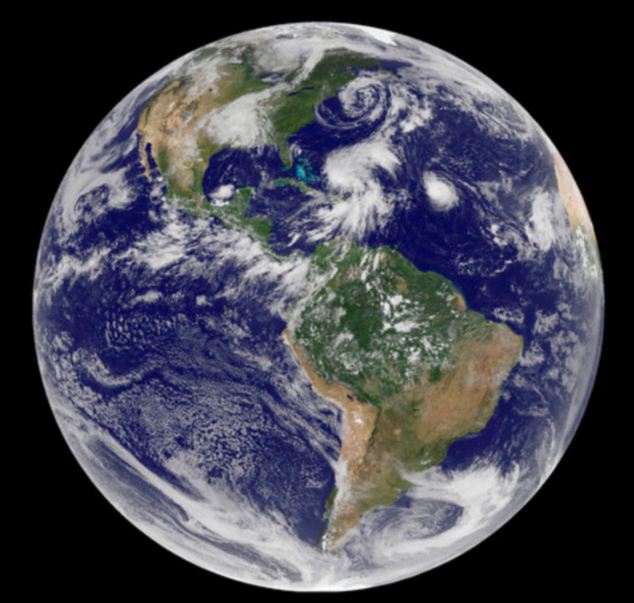Earth’s transition to permanently hosting an oxygenated atmosphere was a halting process that took 100 million years longer than previously believed, according to a new study.
When Earth first formed 4.5 billion years ago, the atmosphere contained almost no oxygen. But 2.43 billion years ago, something happened: Oxygen levels started rising, then falling, accompanied by massive changes in climate, including several glaciations that may have covered the entire globe in ice.
Chemical signatures locked in rocks that formed during this era had suggested that by 2.32 billion years ago, oxygen was a permanent feature of the planet’s atmosphere.
But a new study delving into the period after 2.32 billion years ago finds that oxygen levels were still yo-yoing back and forth until 2.22 billion years ago, when the planet finally reached a permanent tipping point.
This new research, published in the journal Nature on March 29, extends the duration of what scientists call the Great Oxidation Event by 100 million years. It also may confirm the link between oxygenation and massive climate swings.
“We only now start to see the complexity of this event,” said study co-author Andrey Bekker, a geologist at the University of California, Riverside.
Establishing oxygen
The oxygen created in the Great Oxidation Event was made by marine cyanobacteria, a type of bacteria that produces energy via photosynthesis. The main byproduct of photosynthesis is oxygen, and early cyanobacteria eventually churned out enough oxygen to remake the face of the planet forever.
The signature of this change is visible in marine sedimentary rocks. In an oxygen-free atmosphere, these rocks contain certain kinds of sulfur isotopes. (Isotopes are elements with varying numbers of neutrons in their nuclei.) When oxygen spikes, these sulfur isotopes disappear because the chemical reactions that create it don’t occur in the presence of oxygen.
Bekker and his colleagues have long studied the appearance and disappearance of these sulfur isotope signals. They and other researchers had noticed that the rise and fall of oxygen in the atmosphere seemed to track with three global glaciations that occurred between 2.5 billion and 2.2 billion years ago. But strangely, the fourth and final glaciation in that period hadn’t been linked to swings in atmospheric oxygen levels.
The researchers were puzzled, Bekker told Live Science. “Why do we have four glacial events, and three of them can be linked and explained through variations of atmospheric oxygen, but the fourth of them stands independent?”
To find out, the researchers studied younger rocks from South Africa. These marine rocks cover the later part of the Great Oxidation Event, from the aftermath of the third glaciation up to about 2.2 billion years ago.
They found that after the third glaciation event the atmosphere was oxygen-free at first, then oxygen rose and dropped again. Oxygen rose again 2.32 billion years ago – the point at which scientists previously thought the rise was permanent. But in the younger rocks, Bekker and his colleagues again detected a drop in oxygen levels. This drop coincided with the final glaciation, the one that hadn’t previously been linked to atmospheric changes.
“Atmospheric oxygen during this early time was very unstable and it went up to relatively high levels and it fell down to very low levels,” Bekker said. “That’s something we didn’t expect until maybe the last 4 or 5 years [of research].”
Cyanobacteria vs. volcanoes
Researchers are still working out what caused all these fluctuations, but they have some ideas. One key factor is methane, a greenhouse gas that’s more efficient at trapping heat than carbon dioxide.
Today, methane plays a small role in global warming compared with carbon dioxide, because methane reacts with oxygen and disappears from the atmosphere within about a decade, whereas carbon dioxide sticks around for hundreds of years. But when there was little to no oxygen in the atmosphere, methane lasted a lot longer and acted as a more important greenhouse gas.
So the sequence of oxygenation and climate change possibly went something like this: Cyanobacteria began producing oxygen, which reacted with the methane in the atmosphere at the time, leaving only carbon dioxide behind.
This carbon dioxide wasn’t abundant enough to make up for the warming effect of the lost methane, so the planet started to cool. The glaciers expanded, and the surface of the planet became icy and cold.
Saving the planet from a permanent deep-freeze, though, were subglacial volcanoes. Volcanic activity eventually boosted carbon dioxide levels high enough to warm the planet again. And while oxygen production lagged in the ice-covered oceans due to the cyanobacteria receiving less sunlight, methane from volcanoes and microorganisms again began to build up in the atmosphere, further heating things up.
But volcanic carbon dioxide levels had another major effect. When carbon dioxide reacts with rainwater, it forms carbonic acid, which dissolves rocks more quickly than pH-neutral rainwater. This faster weathering of rocks brings more nutrients such as phosphorus into the oceans.
More than 2 billion years ago, such a nutrient influx would have driven the oxygen-producing marine cyanobacteria into a productive frenzy, again boosting atmospheric oxygen levels, driving down methane and starting the whole cycle again.
Eventually, another geological change broke this oxygenation-glaciation cycle. The pattern seems to have ended about 2.2 billion years ago when the rock record indicates an increase in organic carbon being buried, which suggests that photosynthetic organisms were having a heyday.
No one knows exactly what triggered this tipping point, though Bekker and his colleagues hypothesize that volcanic activity in this period provided a new influx of nutrients to the oceans, finally giving cyanobacteria everything they needed to thrive.
At this point, Bekker said, oxygen levels were high enough to permanently suppress methane’s oversized influence on the climate, and carbon dioxide from volcanic activity and other sources became the dominant greenhouse gas for keeping the planet warm.
There are many other rock sequences from this era around the world, Bekker said, including in western Africa, North America, Brazil, Russia and Ukraine. These ancient rocks need more study to reveal how the early cycles of oxygenation worked, he said, particularly to understand how the ups and downs affected the planet’s life.
Related content:
50 interesting facts about Earth
Photo timeline: How Earth formed
7 ways Earth changes in the blink of an eye
This article was originally published by Live Science. Read the original article here.



